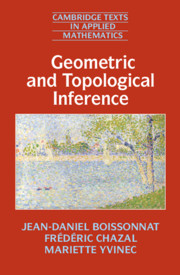Crossref Citations
This Book has been
cited by the following publications. This list is generated based on data provided by Crossref.
Boissonnat, Jean-Daniel
2018.
Géométrie algorithmique : des données géométriques à la géométrie des données.
Lambiotte, Renaud
Rosvall, Martin
and
Scholtes, Ingo
2019.
From networks to optimal higher-order models of complex systems.
Nature Physics,
Vol. 15,
Issue. 4,
p.
313.
Rivera-Castro, Rodrigo
Pilyugina, Polina
and
Burnaev, Evgeny
2019.
Topological Data Analysis for Portfolio Management of Cryptocurrencies.
p.
238.
Choudhary, Aruni
and
Ghosh, Arijit
2019.
Delaunay simplices in diagonally distorted lattices.
Computational Geometry,
Vol. 81,
Issue. ,
p.
33.
Meehan, Killian
Pavlichenko, Andrei
and
Segert, Jan
2019.
On the Structural Theorem of Persistent Homology.
Discrete & Computational Geometry,
Vol. 62,
Issue. 4,
p.
945.
Rataj, Jan
and
Zähle, Martina
2019.
Curvature Measures of Singular Sets.
p.
37.
Almog, Assaf
and
Shmueli, Erez
2019.
Structural Entropy: Monitoring Correlation-Based Networks Over Time With Application To Financial Markets.
Scientific Reports,
Vol. 9,
Issue. 1,
Brécheteau, Claire
and
Levrard, Clément
2020.
A $k$-points-based distance for robust geometric inference.
Bernoulli,
Vol. 26,
Issue. 4,
Zhu, Guomin
Wu, Hongguang
and
Cui, Xiaojun
2020.
Horo-functions associated to atom sequences on the Wasserstein space.
Archiv der Mathematik,
Vol. 115,
Issue. 5,
p.
555.
Paluzo-Hidalgo, Eduardo
Gonzalez-Diaz, Rocio
and
Gutiérrez-Naranjo, Miguel A.
2020.
Two-hidden-layer feed-forward networks are universal approximators: A constructive approach.
Neural Networks,
Vol. 131,
Issue. ,
p.
29.
Kachan, Oleg
2020.
Persistent Homology-based Projection Pursuit.
p.
3744.
Manin, Yuri I.
and
Marcolli, Matilde
2020.
Nori Diagrams and Persistent Homology.
Mathematics in Computer Science,
Vol. 14,
Issue. 1,
p.
77.
Hirsch, Christian
Jahnel, Benedikt
and
Tóbiás, András
2020.
Lower large deviations for geometric functionals.
Electronic Communications in Probability,
Vol. 25,
Issue. none,
Paluzo-Hidalgo, Eduardo
Gonzalez-Diaz, Rocio
Gutiérrez-Naranjo, Miguel A.
and
Heras, Jónathan
2021.
Simplicial-Map Neural Networks Robust to Adversarial Examples.
Mathematics,
Vol. 9,
Issue. 2,
p.
169.
Boissonnat, Jean-Daniel
Kachanovich, Siargey
and
Wintraecken, Mathijs
2021.
Triangulating Submanifolds: An Elementary and Quantified Version of Whitney’s Method.
Discrete & Computational Geometry,
Vol. 66,
Issue. 1,
p.
386.
Krebs, Johannes
Roycraft, Benjamin
and
Polonik, Wolfgang
2021.
On approximation theorems for the Euler characteristic with applications to the bootstrap.
Electronic Journal of Statistics,
Vol. 15,
Issue. 2,
Paluzo-Hidalgo, Eduardo
Gonzalez-Diaz, Rocio
Gutiérrez-Naranjo, Miguel A.
and
Heras, Jónathan
2021.
Optimizing the Simplicial-Map Neural Network Architecture.
Journal of Imaging,
Vol. 7,
Issue. 9,
p.
173.
Chazal, Frédéric
Levrard, Clément
and
Royer, Martin
2021.
Clustering of measures via mean measure quantization.
Electronic Journal of Statistics,
Vol. 15,
Issue. 1,
Chazal, Frédéric
and
Michel, Bertrand
2021.
An Introduction to Topological Data Analysis: Fundamental and Practical Aspects for Data Scientists.
Frontiers in Artificial Intelligence,
Vol. 4,
Issue. ,
Melodia, Luciano
and
Lenz, Richard
2021.
Pattern Recognition. ICPR International Workshops and Challenges.
Vol. 12665,
Issue. ,
p.
15.





